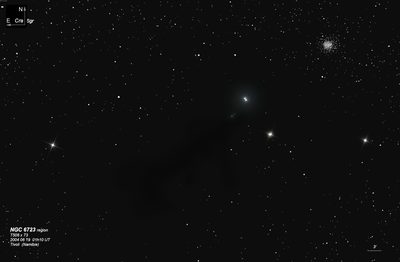
10x30mm (8/8/04 - Haleakala Crater): fairly bright in binoculars, situated just north of the top of the looping curve forming Corona Australis.
James Dunlop discovered NGC 6723 = D 573 = h3770 on 2 Jun 1826 and described "a beautiful bright round nebula, about 3.5' diameter, moderately and gradually condensed to the centre. This is resolvable. The moderate condensation, and the bluish colour of the stars which compose it, give it a very soft and pleasant appearance. This is rather difficult to resolve, although the condensation is not very great." Dunlop made 6 observations and his position is 16' too far east.
John Herschel credited Dunlop with the discovery despite the poor position and recorded on 31 Aug 1834 a "globular cluster; B; L; R or vlE; vgbM; diam 5'; perfectly resolved into stars 14..16m, with stragglers extending to 8' diam." Christian Peters independently found the globular around 1849 at the Capodimonte Observatory in Naples and it was reported as new in AJ 2, 1856. Apparently Peters didn't have access to JH's Cape Catalogue.
200/250mm - 8" (7/31/81): bright, large, bright core, mottled, some resolution of extremely faint stars around edges.
300/350mm - 13.1" (8/24/84): at 220x many faint stars resolved beyond the main disc.
13.1" (5/26/84): bright, large, mottled, many faint stars resolved across disc and at edges of halo.
13.1" (8/15/82): a number of very faint stars resolved around the periphery at 140x.
400/500mm - 17.5" (6/30/00): this is a beautiful, symmetric GC at 220x. The halo extends to ~6' and is sharply concentrated with a very bright 3' core. This core is highly resolved into a dense overlay of faint stars with a single brighter star just north of center. The extent of the halo is ill-defined and consists of numerous brighter stragglers (or field stars) mixed with a sprinkling of dim stars. Perhaps 70 stars are resolved in total. In a remarkable region with a complex of unusual reflection nebulae (NGC 6726/27/29).
17.5" (7/29/92): at 220x, bright, fairly large with about 50 stars visible in a 4'-5' diameter. Fairly symmetric appearance with no distinct edge. Beautifully resolved into several dozen stars. A mag 10.5 star is off the NE edge 3' from the core. Mildly concentrated but no distinct nucleus although a star appears embedded at the center of the core. The outer halo was well-resolved and a peppering of stars was resolved over the core. In the same low power field with bright nebula(NGC 6726, NGC 6727, NGC 6729 to the SE!
Notes by Steve Gottlieb